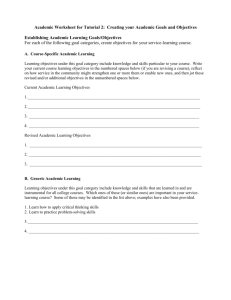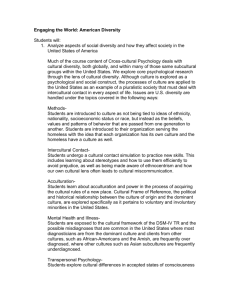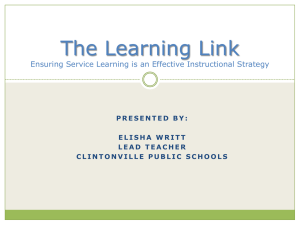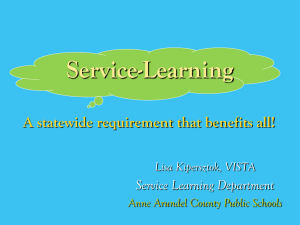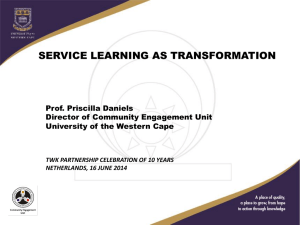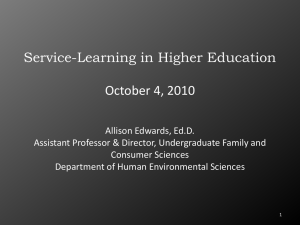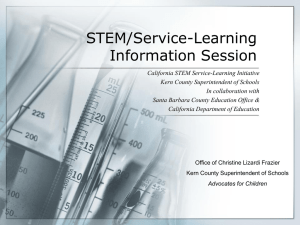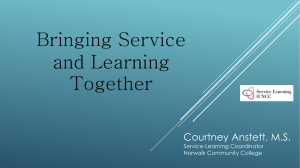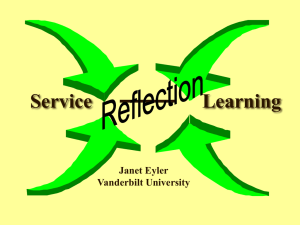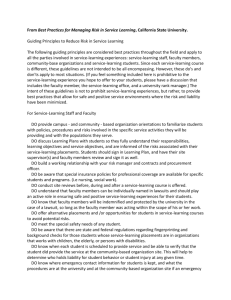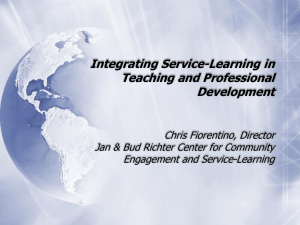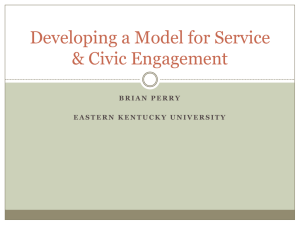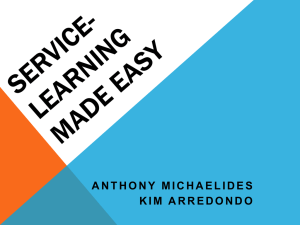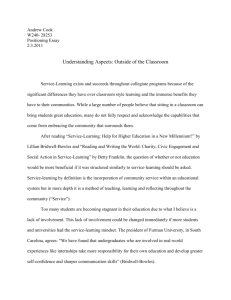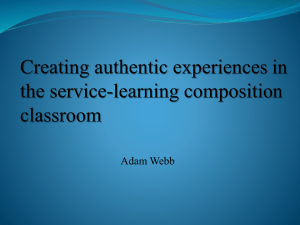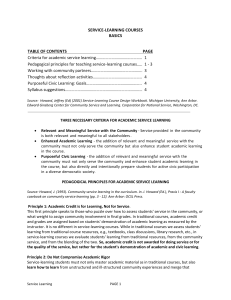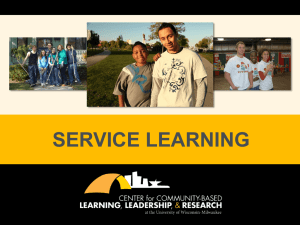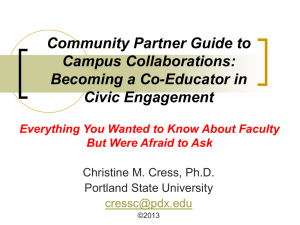Service-learning
advertisement
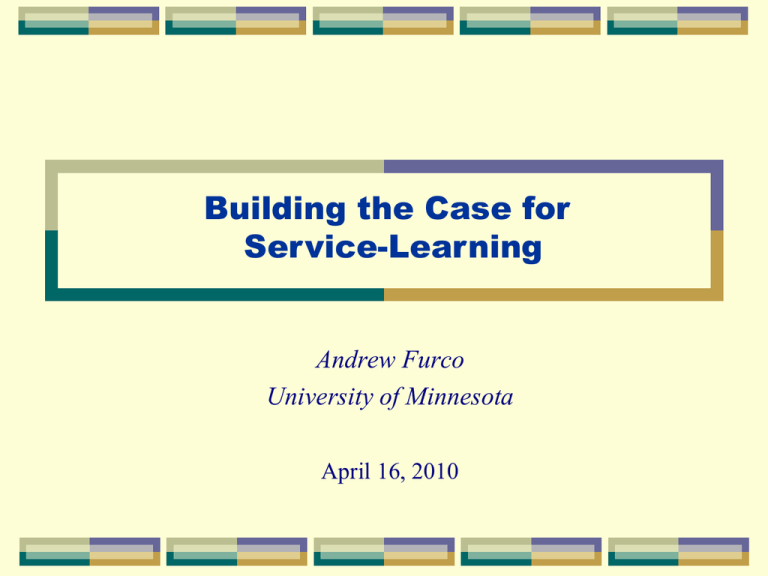
Building the Case for Service-Learning Andrew Furco University of Minnesota April 16, 2010 GROWTH OF COMMUNITY SERVICE AND SERVICE-LEARNING IN THE UNITED STATES (1997-2008) 1997 1999 2004 2008 42% 64% 70% 68% 71% 83% 89% 81% 45% 70% 78% 89% 23% 32% 28% 24% 28% 38% 31% 25% 22% 40% 43% 51% Community Service All Primary & Secondary Schools Secondary Schools Colleges and Universities Service-learning All Primary & Secondary Schools Secondary Schools Colleges and Universities Campus Compact. (1998). Service matters: Engaging higher education in the renewal of America's communities and American democracy. Providence, RI: Campus Compact. Campus Compact, (2001). Campus service participation survey 2000-2001. Providence, RI: Campus Compact. Campus Compact (2005). Campus service participation survey 2005-2005. Providence, RI: Campus Compact. Gray, M.J., Ondaatje, E.H., Fricker, R., Geschwind, S., Goldman, C.A., Kaganoff, T., Robyn, A., Sundt, M., Vogelgesang, L., & Klein, S.P. (1998). Coupling service and learning in higher education: The final report of the evaluation of the Learn and Serve America, higher education program. Santa Monica: The RAND Corporation. National Center on Educational Statistics. (1997). Student participation in community service activity. Washington, DC: U.S. Department of Education. National Youth Leadership Council (2005). Growing to Greatness. Minneapolis, MN: National Youth Leadership Council. Skinner, R. and Chapman, C. (1999). Service-learning and community service in K-12 public schools. National Center for Education Statistics. NCES 1999-043, Washington, DC: U.S. Department of Education. Learn and Serve America, 2008 Building the Case Fact #1: Service-learning incorporates educational elements that help prepare students for success in the contemporary global job market. Successful Global Workforce Success in the global workforce will be marked by one’s: • • • • • • ability to make connections across the disciplines; ability to apply knowledge to address complex situations; people skills that allow him/her to work effectively in diverse group settings; capacity for higher order thinking in ways that enhance problem solving and analysis; knowledge about and facility with the global society (e.g. conversing in different languages, having intercultural competencies, etc.); and facility in organizing and utilizing increasing sources of knowledge and information effectively. (New Commission on the Skills of the American Workforce, 2006) Building the Case Fact #2: Service-learning is composed of the elements that define quality teaching and successful learning. Instruction that Promotes Successful Learning In terms of classroom learning, students learn best when the curriculum: emphasizes learning over teaching engages students as active participants in the learning process is student-centered rather than teacher-centered; promotes the development of students’ higher order thinking skills; focuses on making connections among the disciplines; connects new knowledge to what student know by having students construct meaning; is meaningful and/or of interest to students; is brain-based; is socially constructed; and is practiced and used Sources: Slavkin (2004); Marzano, Pikering, and Pollock (2001); Bransford, Brown, and Cocking (1999); Oakes and Lipton (1999). Essence of Effective Teaching & Learning Expands Boundaries Personalized Constructivist Authentic Empowering Collaborative Active Programmatic Approaches Service-learning is part of a suite of experiential instructional strategies that promote successful learning Instructional Strategies: • problem-based • project-based • service-based • work-based • adventure-based • game-based Essence of Effective Teaching & Learning Expands Boundaries Personalized Constructivist Authentic Empowering Collaborative Active Building the Case Fact #3: Service-learning promotes the civic involvement of young people. Knowledge of National & Global Issues of Importance What percentage of young Americans (ages 18-24) can accurately identify the following places on a map? Iraq 33% Afghanistan 12% New York State 50% Wh\ Building the Case Fact #4: Service-learning creates conditions and opportunities that support students’ academic achievement and educational success. Student Outcomes DOMAIN OUTCOMES CAREER Increased retention; content knowledge and skills; higher order thinking Civic responsibility; commitment to service Career awareness and skills ETHICAL/MORAL Values development PERSONAL & SOCIAL Self-esteem, empowerment, motivation, engagement (academic, civic, social); prosocial behaviors ACADEMIC CIVIC Impacts of Service-Learning Mediating Factors ServiceLearning Self-Esteem Empowerment Prosocial behaviors Motivation Engagement High Quality Components Academic Success Preferences TYPE EXAMPLE Charity Serve food to the homeless on Saturdays Empowerment Service Educate the homeless about social services available to them Public Work Facilitate the opening of a homeless shelter Participatory Democracy Work to secure legislation and citizen support that will secure rights for persons. Social Action Students organize a camp out on campus to raise awareness about homeless Social Change Work to reduce the number of homeless persons; train homeless persons for jobs Social Justice Secure legal assistance for a homeless person who was denied health services
